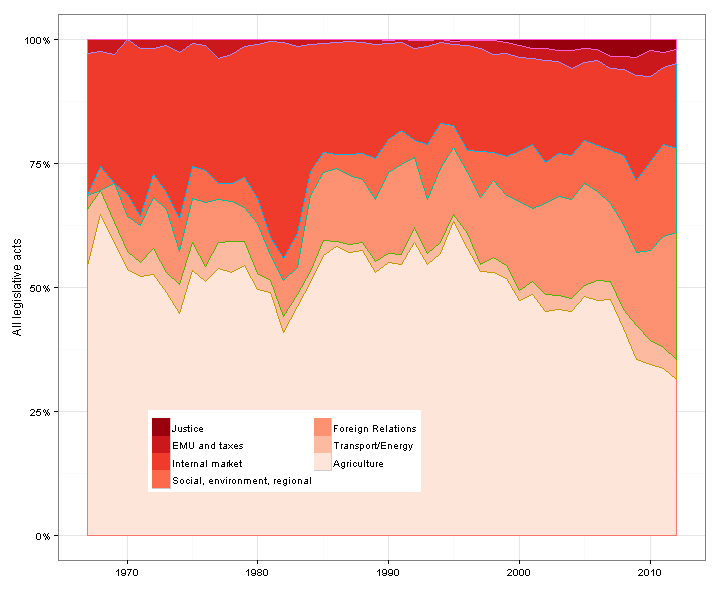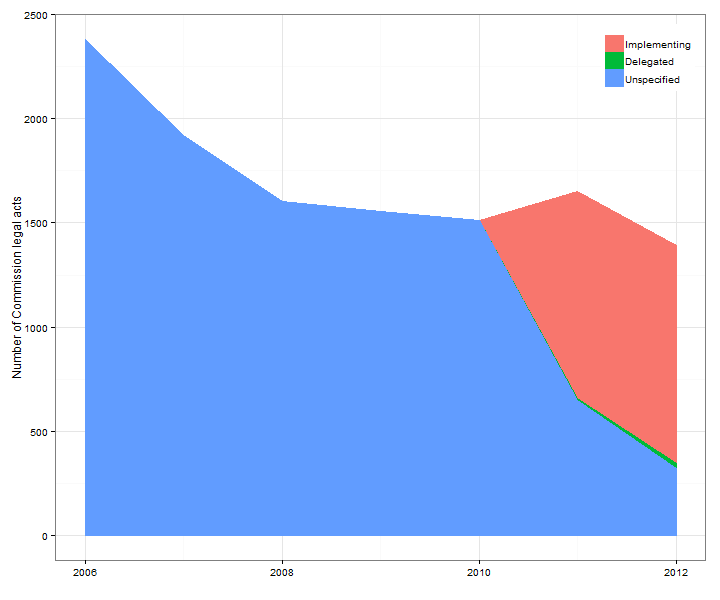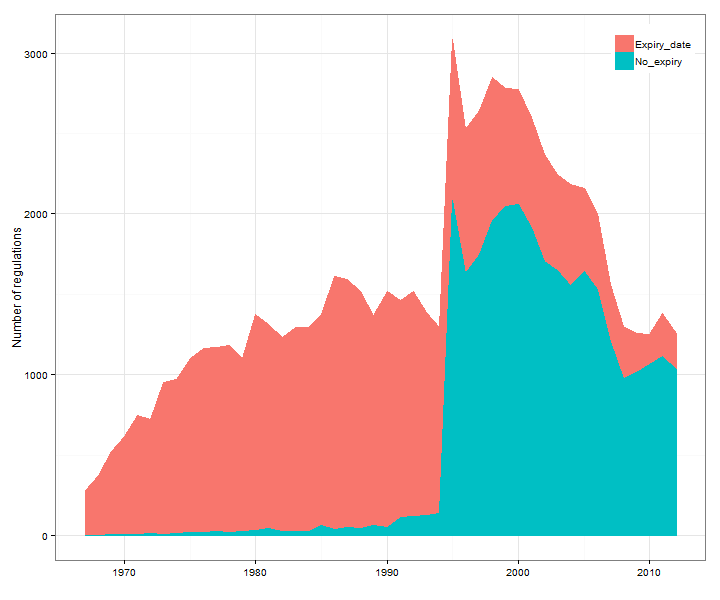


Nota bene: if you are interested in more recent data on EU legislation, check out this presentation and this GitHub repository.
The European Communities, destined to become the European Union
we all know today, were established back in 1957 in Rome. Since, the European Union has adopted more than 100 000 (one hundred thousand) legislative acts.
That's a lot of legislation! This presentation provides a closer look into the evolution of EU legislation
over time.Read on!

Figure 1
shows the number of directives, regulations and decisions adopted by the EU
from 1967 till 2012.
1. EU legislation comes in three main forms: directives, regulations, and decisions. Directives are the most important and most general of the three. There are many important regulations as well, but usually regulations have a more narrow focus and limited application time. Decisions are the least general of the three. Directives are like real laws, and regulations and decisions are like government decrees.
We see that the annual number of legislative acts adopted by the EU has been steadily growing till the mid-1990s, but afterwards the growth has slowed down, and for regulations has been reversed. Nowadays,
the EU approves on average 80 directives, 1200 regulations and 700 decisions per year. Still quite a lot!
And look at the wild yearly variation in the number of directives adopted after 2000!

Figure 2
shows the number of directives according to their author adopted from 1967 till 2012.
2. But not all directives are created equal. 'Regular' directives are adopted by
the Council of Ministers of the EU or after 1993 by the Council and the European Parliament (EP) acting together (under the so-called co-decision, currently rebranded as the 'ordinary legislative procedure').
The Commission also can adopt something called 'a directive', but this is a rather different animal altogether: Commission directives are delegated acts which can only update and fill in the details of existing regular directives, and only when explicitly authorized by the Council and the EP. If you think that's confusing, the Treaty of Lisbon introduced a further distinction between Implementing and Delegated directives.
Nice work, Lisbon!
We can see that the number of regular directives approved every year has been falling since the mid-1990s. If we disregard the year 2008 and the delegated Commission acts, over the last ten years the EU has not been more productive than during the late 1970s.

Figure 3
shows the number of new and amending Council/Co-decision directives adopted from 1967 till 2012.
3. Even if the annual legislative output is falling or stagnating,
it still means that the EU powers are expanding, although at a declining rate, right? To answer this question we have to zoom in even further onto regular directives and check out how many
are genuinely new and how many modify (amend) existing legislation.
It looks like after the peak years of the Single Market Program (from the late 1980s till the mid-1990s)
the EU has approved on average 20 new 'real' directives per year. Now, that doesn't look so impressive anymore. Instead of an explosion of legislation, over the last 20 years there has been
stagnation, if not decline, in the legislative productivity of the EU.

Figure 4
shows the policy sector distribution of EU legislation (all types of acts) adopted from 1967 till 2012.
4. What about the substance of the legislation?
What topics do EU rules deal with? To answer this question we can look at the composition of EU legislation according to policy area over time.
In 2012 Agriculture and Fisheries still account for 30% of all EU legisaltive acts, and although the share is falling, it is still the biggest. Foreign Relations seems going strong only because the numbers include the Common Commercial policy as well. There has been a gradual increase in the amount of legislation in the fields of Social, Environmental, & Consumer protection, and Regional Policy. As expected, Internal Market and Industrial Policy regulation comprises another big chunk, while in terms of legislation, Economic and Mpnetary Union, Taxation, and Justice and Home Affairs are hardly registering on the graph (again, this doesn't mean that the impact of EU activity on the national level in these areas is negligible).

Figure 5
shows the number of implementing and delegated legal acts adopted by the Commission since 2006.
5. Still interested? One of the major concerns of politics in the EU is the power of the Commission to adopt legislation. To ensure that the Commission is properly supervised, the Treaty of Lisbon introduced a distinction between Implementing and Delegated acts (directives, regulations, and decisions).
With Delegated acts the Commission can supplement or amend certain non-essential elements of regular legislation. Delegated powers are given explicitly and the Council and the European Parliament can recall Delegated acts if needed.
With Implementing acts on the other hand, the Commission is given the power to implement regular EU rules.
Even specialists don't quite agree exactly what the differences are, and the EU institutions are regularly fighting over which definition should apply. Some claim that since the introduction of these new types of acts, the Commission has been increasing its power by adopting more Implementing rather than Delegated acts.'
And, indeed, we see that the share of Implementing acts from all legislation adopted by the Commission is growing since their introduction. Currently, around 2/3 of all acts are Implementing legislation which provides the Commission with considerable discretion.

Figure 6
shows the number of implementing and delegated legal acts adopted by the Commission since 2006.
6. And last bet not least. We already noted that regulations account for a great share of EU rules. But regulations can range quite a bit in their importance: while some are general and truly consequential, others concern more trivial matters like an appointment or a change to some intra-institutional rule. One way to account for the differences in importance is to separate regulations which have a fixed date of expiry from those who are in force indefinitely. A date of expiry is often called a 'sunset close'.
Well, most regulations appear to be adopted without a sunset-clause, and the share of those with an expiry date has been steadily falling since the late 1990s.
Let's hope all these never-ending regulations are worth having!
In conclusion, while the EU has adopted a lot of rules over the last 55 years,
the years of peak legislative productive are long past, over one third of all rules still concern Agriculture, and the number of important new laws adopted every year is actually quite small, and falling. Implementing Commission legislation, regulations without an expiry date, and general decisions are growing in importance at the expense of Delegated acts, sunset-clauses, and decisions with a specific addressee.
The composition of EU law is slowly changing to fit a more mature Union.
This presentation has been put together by Dimiter Toshkov and last updated in February 2014.
The presentation is based on data from Eurlex extracted with Python and graphed with the ggplot2 library in R.
If you end up using the material or the data, please provide the following reference:
Toshkov, D. (n.d.) '55 years of EU Legislation', Online presentation, Available at: http://www.dimiter.eu/Eurlex.html
